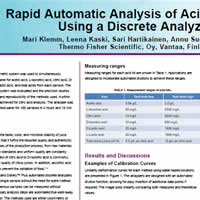Resumo do Pôster:
1. Introduction
Acids play a significant role in the taste, colour, and microbial stability of juice. Analysis is essential to ensure that it fulfills the required quality and authenticity characteristics. In various phases of the production process, from raw materials to finished products, the health standards and uniform quality are constantly confirmed. Laboratories choose automated methods for ease-of-use and optimized application, resulting in smaller volumes of reagents required and enabling low costs per test.1-4
Discrete analysers measure several acids from a single sample without the need for extra method changeover time. Most homogenous samples can be measured without pre-treatment. Since the necessary analysis steps are automated true walk-away time is provided for the operator. The methods used are either colorimetric or enzymatic and some analysis is done by automating traditional titration methods. Discrete cell technology allows for measurement of several different tests for the same sample simultaneously without method changeover time, and offers faster, reproducible results.
In this work, an automated, discrete photometric system was used to determine acetic, L-ascorbic, citric, D-isocitric, D-lactic, L-lactic acids, and total acids simultaneously in each sample. Measuring ranges and performance data for the analyzer used are described. From performance data, the correlation graphs illustrate the quality control sample concentration plotted against a theoretical calculated concentration. Precision studies demonstrate the repeatability and reproducibility of the methods used. In less than ten minutes after insertion of test samples into the analyzer, results are obtained.
2. Purpose
Evaluate the capability of an automated discrete analyzer to measure several analytes from a single sample without the need for extra method changeover.
3. Method
The analyser used in this work has a system reagents ready-to use. Reagent volumes are optimized for the system application; typically, an average of 300 test results can be reported from each kit. Reagent vials are bar-coded. Embedded in the barcode is the material lot number and expiration date and as part of its programming, the instrument sounds an alarm when the reagent is almost finished and will automatically calibrate after the insertion of a new reagent vial. In addition to the reagent’s on-board stability, the instrument has the capability to fully trace reagents and store results, including associated calibrations and reagent lot data.
The analyzer is pre-programmed with the methods to test various acids in its application menus. Application parameters are adapted to test less than 300 µL of total volume where the sample and first reagent are usually blanked to eliminate any color interference.
4. Results and Discussion
Examples of linearity performance curves for each method using water based solutions are presented in Figures 1 and 2. The anlayzer is designed with an automated dilution function, allowing for easy insertion of additional data points if required. The image plots linearity comparing both measured and theoretical values. All r2 values were >0.999 except for L-lactic acid which was equal to 0.997.
Examples of the results of the precision studies performed with the analyzer are shown in Table 1. Usually, three sample levels with at least 10 replicates were tested every day for 5 days. The assay was calibrated daily between batches. The highest coefficient of variation observed was equal to 4.0% (not shown in Table 1).
5. Conclusion
The automated discrete analyzer used in this work has the capability to measure several acids from a single sample without the need for extra method changeover time. Since the analyzer can automate sample dilutions, methods are designed to accurately measure large concentration ranges. Methods were repeatable; a within run CV% as low as 0.5% can be achieved for citric acid analysis (not shown in Table 1). When comparing the calculated concentration to measured concentrations, an r2= 0.997 or better was obtained.
Results are fully traceable and designed for ease of use. Optimized applications result in the use of very low volumes of reagents which enable low costs per test. Discrete cell technology offers rapid quality and authenticity testing for juice samples. The analysis of 100 samples using the total acids test requires only 35 minutes.
6. References
- Beutler, H. O. Methods of Enzymatic Analysis. L-Ascorbate and L-Dehydroascorbate. 3rd ed; Bergmeyer, H. U., Ed.; VCH Publishers (UK) Ltd., Cambridge, UK, 1988: Vol. VI, pp 376-385.
- International Federation of Fruit Juice Producers (A.I.J.N), IFUMA22, Determination of Citric Acid (enzymatic).
- Compendium of International Methods of Analysis, Citric acid, Method OIV-MA-AS313-09: R2009 1.
- IHS Engineering 360, Standard: DS - DS/EN 1137, Fruit and Vegetable Juices - Enzymatic determination of citric acid (citrate) content- NADH spectrometric method.
|

